A Comprehensive Guide to eCommerce in China
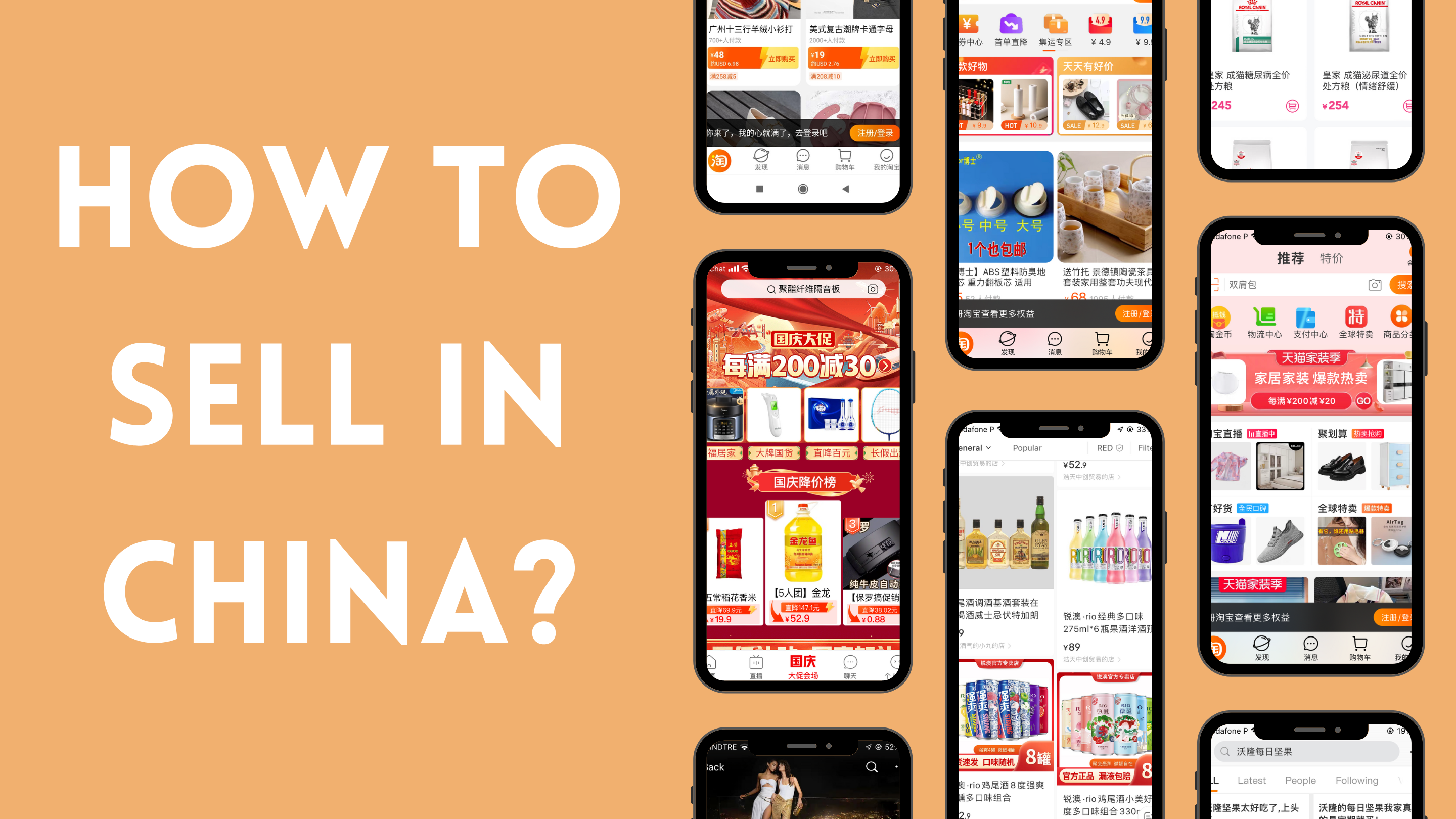
China has become the largest e-commerce market in the world, accounting for almost half of all global transactions. With a thriving economy and over one billion consumers ready to purchase goods and services online, it’s no wonder why businesses are flocking to this market. However, understanding China’s unique consumer behavior, cultural impact, and e-commerce regulations can be challenging for those unfamiliar with the country.
In this guide, we’ll provide an overview of China’s e-commerce market, discuss key platforms for selling online, explore new trends in Chinese e-commerce marketing strategies, and offer insights on how you can successfully enter this lucrative market. Join us as we dive into our comprehensive E-Commerce in China Guide!
Cost-Effective Agency
KPI and Results focused. We are the most visible Marketing Agency for China. Not because of huge spending but because of our SMART Strategies. Let us help you with: E-Commerce, Search Engine Optimization, Advertising, Weibo, WeChat, WeChat Store & PR.
Overview Of The Chinese E-commerce Market
In today’s rapidly growing digital world, e-commerce has taken center stage as the go-to shopping method for consumers worldwide. Amongst all countries, China stands out as the undisputed global leader in e-commerce, boasting a staggering market share of almost 50% and generating an estimated revenue of over 17 trillion RMB in 2023 alone.
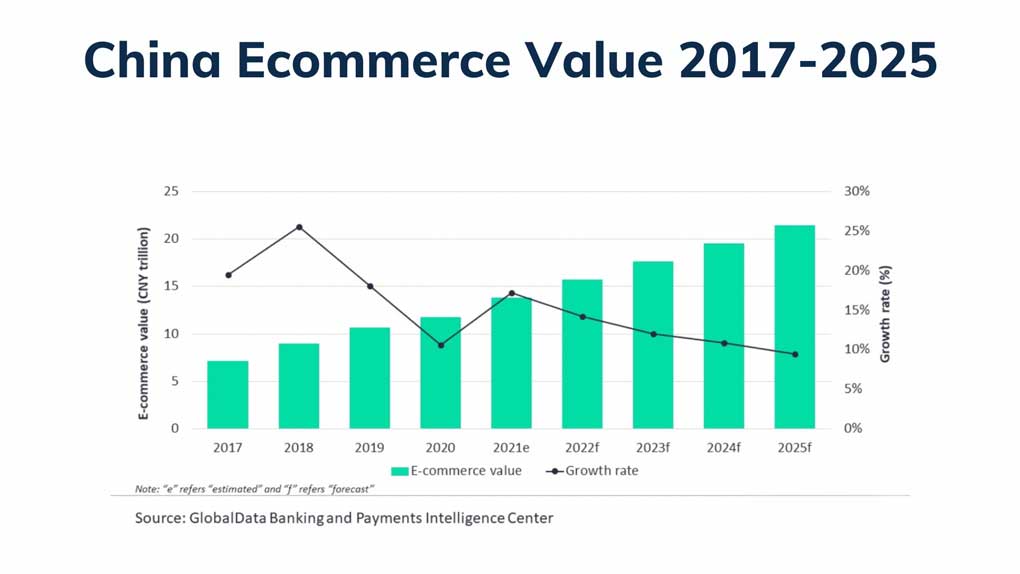
With more than one billion tech-savvy consumers hungry for diverse products and services, it comes as no surprise that businesses are eager to tap into this lucrative market.
To succeed with e-commerce in China, you need to understand your target audience thoroughly. Chinese consumer behavior and preferences are unique, with a strong emphasis on social media platforms like WeChat and Xiaohongshu.
When it comes to choosing a Chinese eCommerce platform for your business, consider Tmall or JD.com as top options with significant market share.
It’s also critical to keep up-to-date with new trends emerging within the industry – such as live-streaming events and user-generated content.
Chinese Consumers’ Characteristics and Shopping Behaviors
Chinese consumer behavior and preferences are very different from those in Western countries. With an increasing purchasing power and consumption rate, these consumers are more demanding than ever before.
In addition, tradition plays a significant role in consumer behavior in China. Social connections and group decisions carry weight, as does reputation management for both brands and retailers.
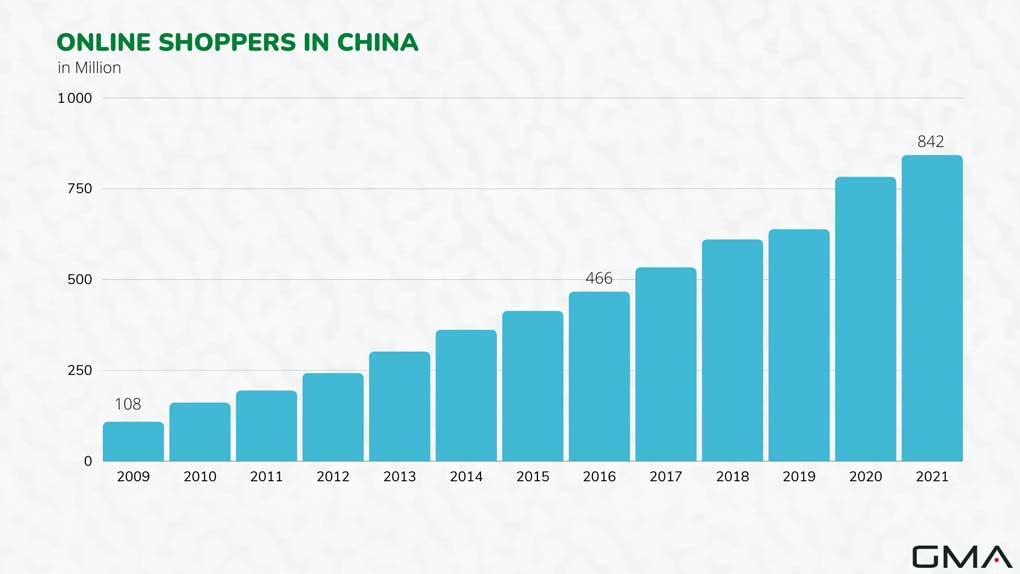
Value for money is also crucial; Chinese consumers expect high-quality products at reasonable prices.
To capture the attention of these discerning customers, marketers must cater specifically to their needs by building brand trust with transparent product information, emphasizing social proof such as reviews from previous customers or influencers on social media channels like WeChat or Xiaohongshu.
The Impact Of Culture On E-commerce In China
Culture plays a vital role in e-commerce in China, and it is important for businesses to understand the cultural nuances to successfully navigate this market. For example, face-saving is significant in Chinese culture, and individuals often avoid conflict or criticism publicly.
This can lead to customers leaving positive reviews even if they may have had a negative experience with a product.
Additionally, gift-giving is customary in China’s culture and can be used as an effective marketing tool by businesses.
Moreover, language barriers are another critical factor for e-commerce success in China. Mandarin is the official language of China; thus, investing resources into localizing websites will increase credibility among potential customers who prefer shopping on sites that cater to their needs.

Most Popular Platforms For E-commerce In China
Chinese e-commerce platforms such as Tmall, JD.com, Pinduoduo, and Taobao are crucial for businesses looking to sell their products or services online in China.
Tmall
Tmall is the largest online platform in China’s eCommerce market, owned by Alibaba Group Holding Ltd. With over 800 million buyers and a market share of over 60% in China’s B2C e-commerce business, it plays a significant role in the domestic Chinese market.
Tmall Global is a sub-platform of Tmall that enables international merchants to do cross-border commerce in China. As part of its services, Tmall provides marketing tools such as targeted ads and data analytics that can help businesses attract more customers to their products.

JD.com
JD.com is a significant player in the Chinese e-commerce market, providing high-quality products and services to its growing consumer base. As one of the two massive B2C online retailers in China by transaction volume and revenue, JD.com is quickly becoming a major competitor to Alibaba.
The company has diversified its business segments to deliver all kinds of products, including fresh and frozen goods across China. In 2015, JD.com launched its JD Worldwide cross-border online shopping platform serving as a challenger to other cross-border e-commerce platforms in China.

Pinduoduo
Pinduoduo is a Chinese e-commerce platform that was founded in 2015. It offers all kinds of products, from daily groceries to home appliances and fashion items.
As of 2022, Pinduoduo has over 640 million users and has become the second-largest e-commerce platform in China, trailing only Alibaba. What sets Pinduoduo apart is its unique group buying feature, which allows users to team up with their friends or family members to purchase items at reduced prices.
This social approach to online shopping has quickly gained popularity among Chinese consumers, especially those living in smaller cities or rural areas who are looking for high-quality products at affordable prices.

Taobao
Taobao is a leading online shopping platform in China that allows consumers to buy products from other consumers. As the biggest consumer-to-consumer (C2C) e-commerce platform in China, Taobao has transformed the way people shop and has facilitated more than $1 trillion worth of transactions since its inception.
One of the most interesting aspects of Taobao is that it’s run entirely on user-generated content. This means sellers create their own product pages with detailed descriptions, photos, or videos which help buyers make informed decisions about what they’re buying.
What sets this online shopping platform apart from others is its unique social networking features like chat rooms where users can interact with each other to exchange information about a product they are interested in buying or selling.
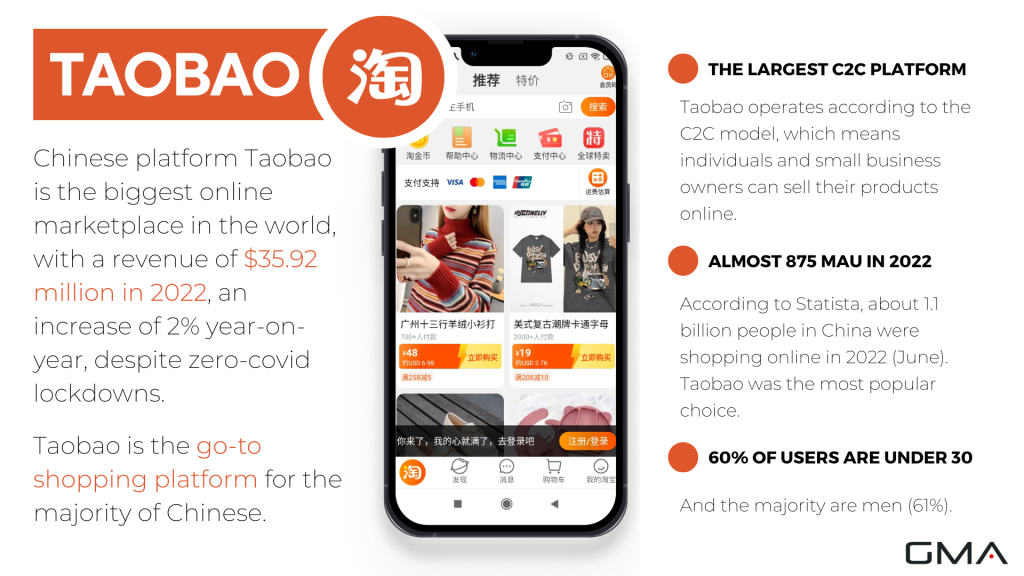
Social E-commerce
Social e-commerce is a growing trend in China, with platforms like WeChat, Xiaohongshu, and Douyin offering unique opportunities for businesses to connect with customers and drive sales through social media.
WeChat is a social media platform that has evolved into a powerful marketing tool for businesses looking to reach Chinese consumers. It’s the largest social network in China, with over 1.26 billion active users.
WeChat’s e-commerce features have made it an even more attractive platform for businesses since 18% of its mini-programs are dedicated to generating sales in China.
In addition to being a messaging app and social media platform, WeChat also offers payment functions and other convenient services such as taxi-hailing and restaurant reservations.

Xiaohongshu
Xiaohongshu (also called Little Red Book) is a hybrid of social media and e-commerce, with a strong focus on the beauty and fashion markets.
Xiaohongshu provides users with an in-app shopping experience, allowing them to discover new products and read user reviews before making purchasing decisions.
This presents an incredible opportunity to target and connect with the Chinese audience through targeted marketing campaigns on this popular platform – particularly among females interested in beauty products or fashion items.
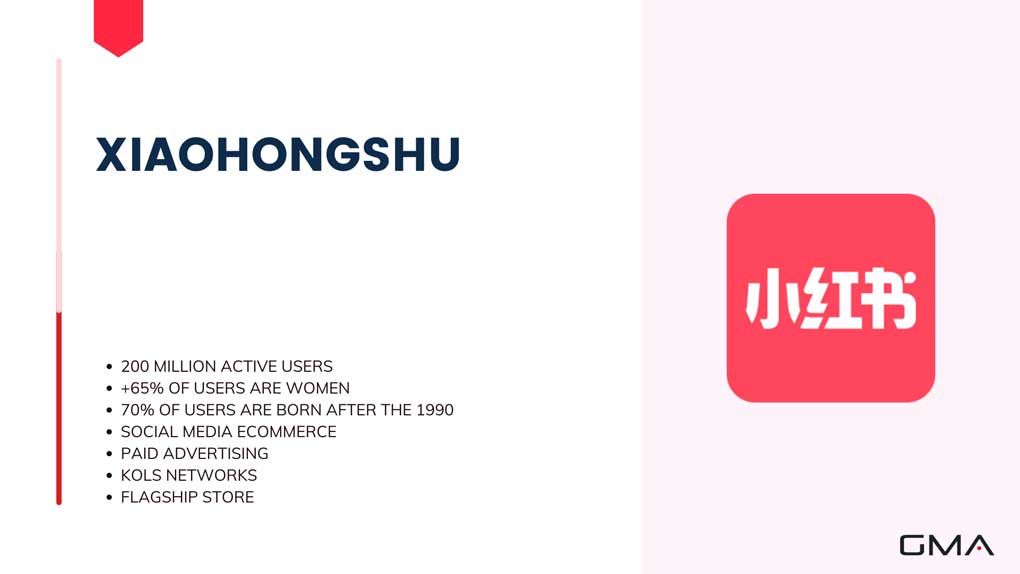
Douyin (Chinese Tik Tok)
When it comes to social e-commerce in China, Douyin is a platform you can’t ignore. With over 600 million active users, this short-video app has become an essential tool for reaching millennials and Gen Z consumers.
Through its e-commerce feature, brands can integrate their entire sales strategy, from promotion to transaction completion, all in one platform.
What sets Douyin apart from other social media platforms is that users welcome brand advertising on the app. In fact, promotions and campaigns featuring popular public figures go viral within hours of their release on Douyin.
Livestreaming is another hugely effective marketing strategy that also complements social commerce; they are fun to watch and also offers users real-time engagement with brands and products.
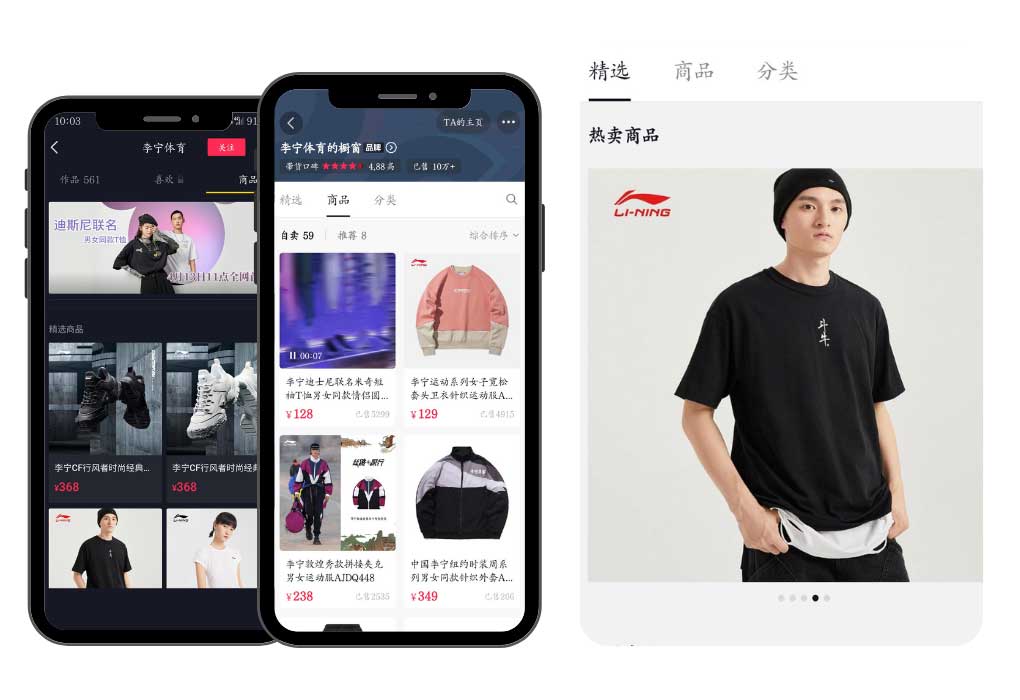
Cross-Border E-commerce In China
Cross-border e-commerce in China presents substantial opportunities for businesses looking to expand beyond their home markets. From understanding regulations and policies to leveraging emerging trends, exploring this segment of the Chinese e-commerce market is crucial for any business looking to succeed in China’s thriving economy.
Regulations And Policies For Cross-border E-commerce In China
Goods bought through cross-border channels are treated as personal items and are not subjected to commercial regulations. However, companies need to comply with international trade regulations when shipping products into China.
The Chinese government promotes cross-border e-commerce expansion by expanding incentive hubs for this sector’s growth. The regulations and policies ensure the safety of imported goods’ quality while protecting consumers’ interests.
China’s market presents an enormous opportunity for businesses seeking global expansions while navigating various rules enforced by different countries worldwide; a clear understanding of these rules can smooth out any challenges faced during strategic planning or market entry/exit strategies.

The demand for foreign goods in China presents a great opportunity for businesses looking to expand their market penetration. However, there are also several challenges that businesses need to be aware of when pursuing cross-border e-commerce in China. One such challenge is navigating through customs procedures which can be complex and time-consuming.
Nevertheless, American firms can benefit from streamlined Chinese customs procedures through China’s over 100 cross-border e-commerce-integrated pilot zones, providing an excellent entry point into the market.
New E-commerce Trends In China
Live streaming in Chinese e-commerce is becoming more popular, so take advantage of this trend to engage with your customers.
Live-streaming In Chinese E-commerce
Livestreaming has become a game-changer for e-commerce sales in China. It allows domestic and foreign brands to interact with customers directly and promotes better engagement than traditional product listings.
The COVID-19 pandemic increased the use of live-streaming e-commerce, as people were forced to stay home and shop online more frequently.
Many popular platforms like Taobao Live are used for integrating live streaming into e-commerce stores on Alibaba’s marketplaces Tmall and Taobao. Additionally, competitors JD.com and Pinduoduo are also utilizing the power of live streaming in their business models.

Virtual Reality As A New Shopping Experience In China
Virtual reality (VR) and augmented reality (AR) are being used by Chinese investors and retailers to offer customers an entirely new shopping experience from their homes.
Brands like Alibaba’s Tmall have integrated VR into their business models to enhance customer experience and increase online sales. For example, during Singles’ Day, Tmall launched a virtual reality game that allowed users to win coupons that they could use towards purchases on its platform.
O2O (Online-to-Offline) Strategy In Chinese E-commerce
One of the newest and most exciting trends in Chinese e-commerce is O2O (Online-to-Offline) strategy. This approach combines online marketing efforts with a physical presence, such as a retail store or showroom, to create a seamless experience for customers.
What’s particularly interesting about this strategy is that it creates an immersive shopping experience that makes use of technology like mobile apps and QR codes to connect with consumers on multiple levels.
The coronavirus pandemic has only accelerated the growth of O2O commerce by pushing consumers even more towards online shopping ─ making hybrid commerce models like brick-and-click and omnichannel important considerations for businesses looking to expand into China.
For example, WeChat’s O2O strategy provides coupons and store locators to drive foot traffic offline while still providing call-to-action buttons like “contact us,” which drives users back online.

Influencer Marketing
From small businesses to large corporations, brands are partnering with Chinese influencers to create brand awareness and boost sales through social media platforms like WeChat, Xiaohongshu, and Douyin (TikTok).
In fact, Influencer Intelligence predicts that 60.9% of Chinese social commerce sales in 2023 will come from influencer marketing. KOLs (Key Opinion Leaders) have a significant impact on online shoppers in China, particularly Gen Z consumers who are heavily influenced by them when making purchasing decisions on popular e-commerce websites like Tmall or JD.com.

To succeed in the Chinese e-commerce market, it’s crucial to understand consumer behavior and preferences. Social media plays a vital role in influencing purchasing decisions, with platforms like WeChat and Xiaohongshu being hugely popular among Chinese consumers.
We Can Help You Enter The Chinese eCommerce Market!
Understanding the Chinese e-commerce market and regulations, as well as consumer behavior and preferences, is crucial for businesses looking to tap into China’s massive online shopping industry.

We are a China-based marketing agency specializing in digital marketing and e-commerce solutions. We help Western brands build a presence in China and generate retail sales through various e-commerce solutions.
If you’d like to enter the Chinese market and start selling your products to Chinese consumers, don’t hesitate to leave us a comment or contact us. Let’s start your China eCommerce journey today!
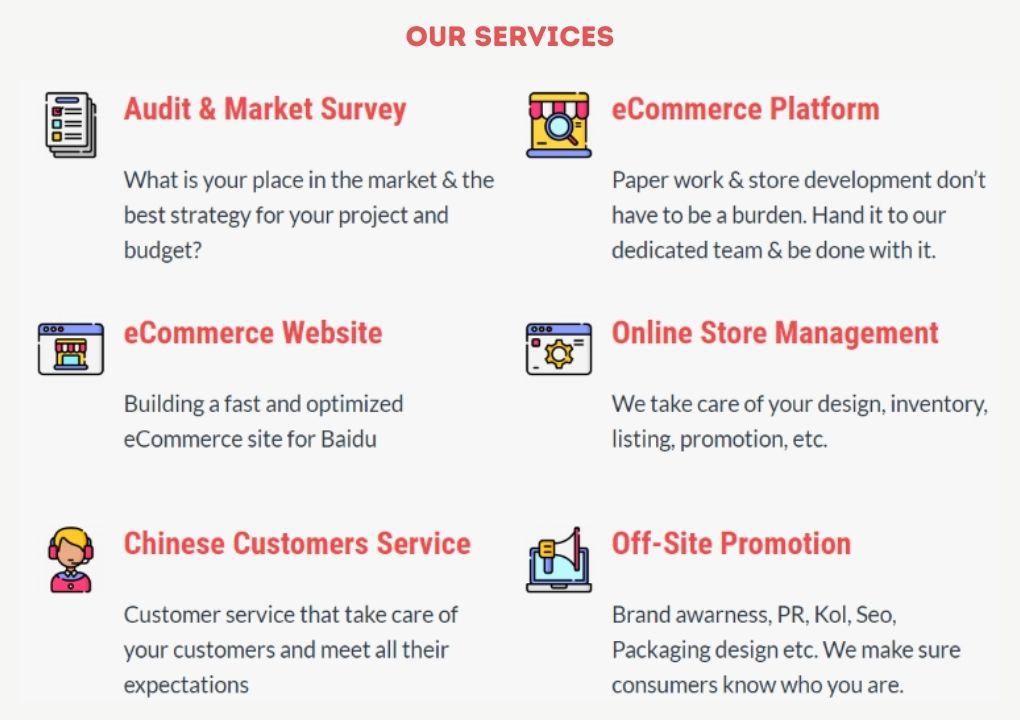






Full discussion on Facebook about this topic on CEO group
https://www.facebook.com/groups/1617494688463171/posts/3506400892905865/